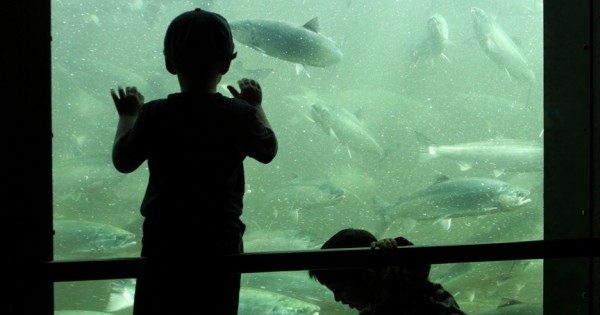Herschel and the Steelheads
It’s time to bust the sea-lion party and save some Seattle salmon

Herschel entered the scene in 1981. By 1984 or 1985 he’d become a Seattle legend. Controversy swirled around his crimes and their proper punishment. He was aggressive. He was a glutton, weighing 800 pounds. He was a California sea lion (Zalophus californianus).
Herschel inaugurated his bad name by arriving at the Ballard Locks each year in time to dine on wild steelhead (Oncorhynchus mykiss) during their winter run. The original Herschel, named by a locks operator, returned each fall for several years, after which his successors got the name. Herschel’s prey are anadromous (an-ADD-romous) fish—the kind that hatch in fresh water, travel to salt water to live and grow, then return to fresh water to spawn. (A freshwater type of Oncorhynchus mykiss that never goes to sea is called rainbow trout.)
Seattle’s cement-walled Ballard Locks form a barrier between the lower salt water of Puget Sound and the higher fresh waters of Lake Union, Lake Washington, and the rivers that drain into them. Built in 1917 by the United States Army Corps of Engineers, the locks are a quintessential part of Seattle’s maritime commerce; some 75,000 vessels are locked through each year. A crude fish ladder was part of the original locks, but in 1976 it was rebuilt using more current knowledge of fish biology. (The ladder is a series of small pools rising like steps to the lakes, with fresh water rushing down. To an anadromous fish, it’s very riverlike.) Four main runs of salmon swim up the fish ladder each year: chinook, coho, sockeye, and steelhead. Several runs are listed as “threatened” under the federal Endangered Species Act.
The steelhead run coincides with arrival of sea lion bulls that have migrated north from the coasts of Mexico and California. In 1983, 2,600 steelhead swam up the fish ladder. In 2012 perhaps four were counted. Virtually none. When the fish arrive at the locks, they must rest on the salty Puget Sound side while their metabolism adjusts to the transition to fresh water before the tremendous exertion of the upriver swim. Enter Herschel to gorge and haphazardly maul. In natural estuaries, during this rest period, steelhead hide among rocks and seaweed. The locks and, farther south, the dammed Columbia River, are estuaries (where fresh and salt waters meet), but they are no longer natural estuaries. A cement wall is no place to hide from a predator.
Sea lions are protected under the federal Marine Mammal Protection Act of 1972. In the 1950s, according to the Washington Department of Fish and Wildlife, there were only about 10,000 California sea lions left. Now the count is 300,000, about the environment’s carrying capacity.
Sea lions are Pinnipeds, a suborder of fin-footed Carnivores that also includes seals, walruses, and sea lions. Their hind flippers fold under to function on land more or less like legs. They are smart, sociable, and playful. They surf, apparently for the fun of it, and mock fight and sleep in piles of each other. They have a very human-sounding bark.
California sea lions live in colonies of many females and many fewer males all along the Pacific coast. They congregate on remote islands, or on piers or oil platforms. During breeding season, a bull claims a territory, mates with as many females as possible, and guards his harem ferociously until, in about two weeks, a rival bull vanquishes him. After the breeding season, the bulls migrate north, leaving the females to raise the pups. That’s why the big steelhead feeders at the Ballard Locks are males.
How to protect the steelhead run? The Washington Department of Fish and Wildlife, along with federal, local, and tribal agencies, have a big problem on their hands. Solutions attempted include trapping the wily beast and transporting him to Point Defiance Zoo in Tacoma for the duration of the run. (Very expensive.) Sea World Orlando in Florida paid for three of the greedy Pinnipeds to be flown in for show-business training. (Most seals balancing balls on their noses are sea lions.) Sea lions were trucked to the Oregon coast (they swam right back, no problem) and then to the coast of San Diego (one sea lion beat the truck back to the Northwest). Other tactics: employ a fake killer whale, the real Orcas being predators of sea lions. (“They must think we’re stupid.”) Firecrackers, poisoned fish, rubber bullets. Nothing has worked.
The steelhead have more to deal with than sea lions. They were once overfished, but now fishing is strictly regulated. Ocean conditions have deteriorated. Also, steelhead require cold lakes and, due to urbanization, Lake Union and Lake Washington are warmer than they used to be. But in recent years it’s the sea lions that have been the main nemesis of the steelhead.
But not all the sea lions. It turns out that the deterrents (such as the ultrasound noisemaker currently in place) do thwart most sea lions. It’s only when one or two dominant individuals are allowed to gobble the run that others follow.
The Marine Mammal Protection Act has been amended, and states may now, as a last resort, “lethally remove” individual California sea lions that threaten the salmon runs.
I revere the sea lions. Once we nearly wiped them out, but we intervened to save the species, and we succeeded. Now it’s the steelhead run we may lose forever. Now it’s time to save the fish. I say, for the Herschels, the party’s over. And that’s life.

